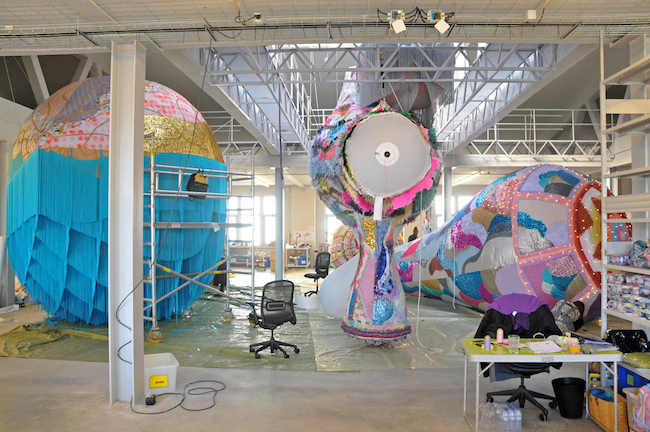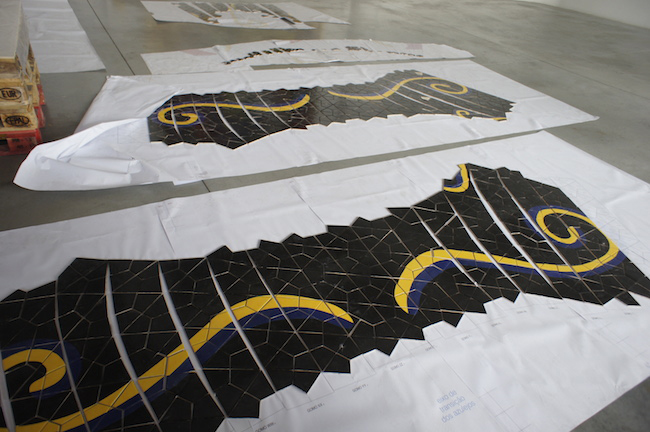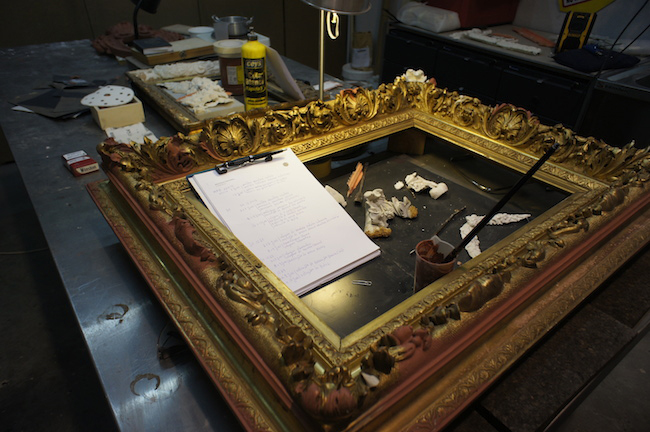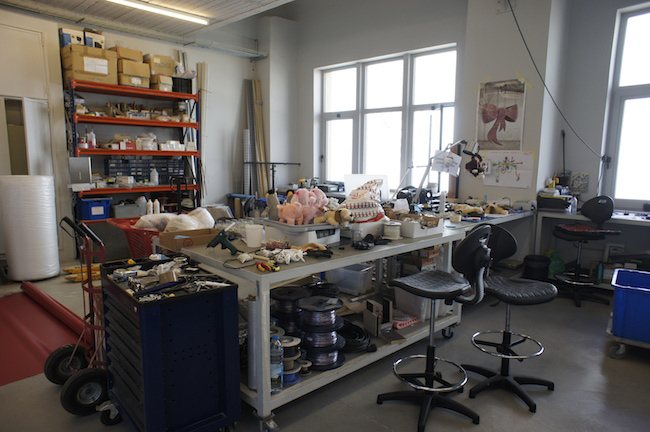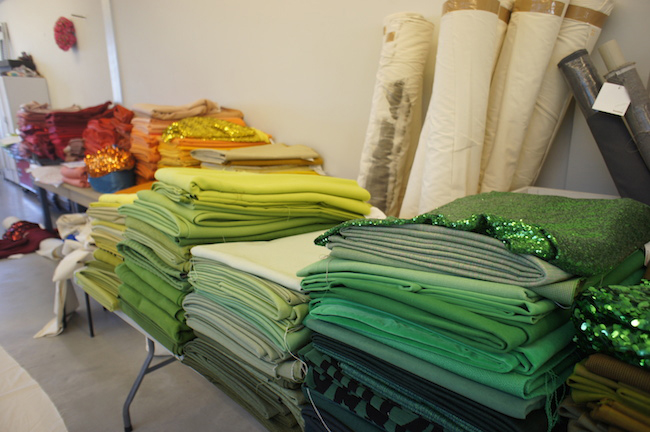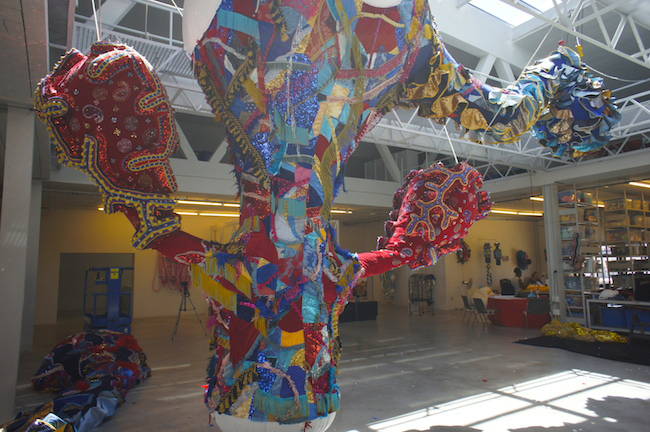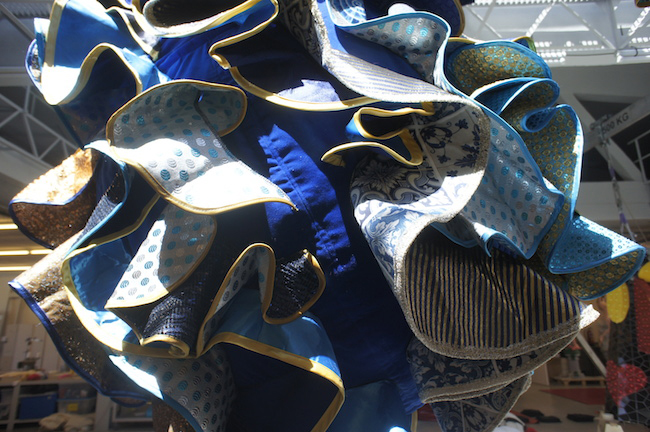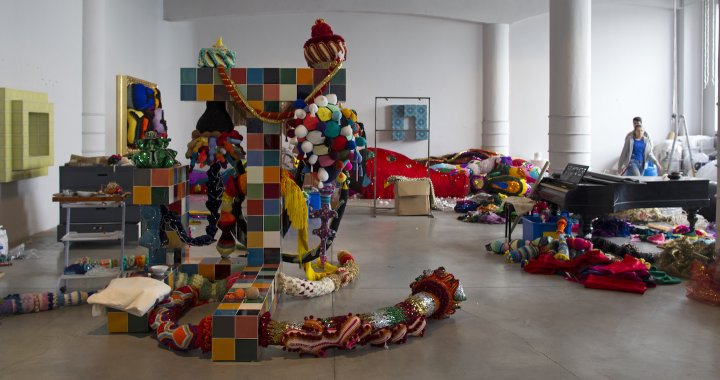
A Microcosm of a Wonderland, Under the Rooster of Barcelos
Joana Vasconcelos’ atelier in Lisbon: a place where Valkyrie and other giants are born
05/08/2016
Portuguese artist Joana Vasconcelos (1971) is currently one of the most spirited women artists on the international contemporary art scene. In 2012 she presented an impressive array of her works at the Palace of Versailles, and in 2013 she represented Portugal at the 55th Venice Art Biennale, where, in spite of the financial difficulties of her country’s national pavilion, she shipped the pavilion – in the form of a ferryboat – from Lisbon to Venice herself. At the moment, Vasconcelos is dynamically working away on the largest piece of her Valkyrie series – a 50-meter-long compilation of textiles for the collection of the ARoS Aarhus Museum of Modern Art – which will be presented on 14 October of this year.
Photo:
20 years ago, the Portuguese artist began her artistic career in a 50-square-meter studio in a different neighborhood of Lisbon, but today her 3000-square-meter atelier is located in a former cereal warehouse lying directly across from the Museu do Oriente – a museum dedicated to the voyages made by Portuguese explorers to Asia, centuries ago.
It is lunchtime on a hot June weekday as I open Vasconcelos’ atelier’s front door (which is marked by the artist’s easily recognizable, primary-color logo) and hear the powerful and melodic voices of men singing a Portuguese tune – and quite well, at that. What I see is even more surprising – two young men (part of Vasconcelos’ 50-person team) singing as they lie under a ten-meter-high sculpture of a rooster covered in tiles. The artwork references one of Portugal’s most reproduced symbols at the moment – the 17th-century legend of Galo de Barcelos, or Rooster of Barcelos.
Photo: Luís Vasconcelos / Cortesia Unidade Infinita Projectos
I greet the singers, who then cease their singing with a whistle – most likely elicited by the occasion of spotting a woman (in summery dress) from such a fortuitous angle. That is also the end of my communication with the singers, for I am immediately met by Aviva Obst, the press relations and agenda coordinator for Vasconcelos’ atelier, who will take me on a tour of the studio.
A material fairy tale: a many-headed creepy-crawly in a Venetian palazzo, and shoes made of pots in Versailles
In reading the numerous online articles on Joana Vasconcelos, one of the most oft-used descriptors of her art – “fairy-tale-like” – has been so overworked that it has been seemingly stapled on to every paragraph written about the artist’s work. Nevertheless, when looking at the creative process from behind the scenes, the epithet is blatantly accurate. Another descriptor could be “wonderland” – with its flights of fantasy and microcosm of paradoxes, and of course, its very own “Alice” – Vasconcelos’ four-year-old daughter, a regular guest at the studio.
In a literary context, adventure is not the only key to the fairy tale genre. Fairy tales teach moral principles and values that are inherited from one generation to the next; they teach critical thinking, throw light upon things that we don’t take the time to appreciate every day, and also instruct us on our culture and traditions.
Vasconcelos’ work is like a material fairy tale which – by way of its characters, forms and plot-lines – carries with it a collection of instructional subjects and experiences that make us ponder how we identify and relate to the things and processes that surround us – including such overarching social issues such as gender equality, social inequality, and national identity. Take, for example, Vasconcelos’ piece “Marilyn” (2009) – a pair of high-heeled “crystal” shoes constructed from stainless steel pots and lids, exhibited at the Palace of Versailles; it visualizes every man’s ideal, fairy-tale woman: a perfect entity that is just as good in social situations as she is in bed and in the kitchen. This work makes one think about gender roles in Western society, whereas the kinetic sculpture “Burka” (2002) is a dramatic message linked to the Arabian woman’s One Thousand and One Nights’ tales.
Valkyrie Octopus, 2015. Photo: ©Unidade Infinita Projectos
Befitting fairy tales, a large role in them is played by the phenomenon of gigantic sizes. Vasconcelos’ record-breaking feats of megalomania were superbly illustrated in the 2011 exhibition of “Contamination” at Venice’s Palazzo Grassi – the vividly colored, snaking body of the many-headed creature spread out its tentacles from the central atrium, and wound through all of the galleries of the palazzo – all three floors of it. In 2015, at the luxury hotel MGM Macau in China, Vasconcelos revealed her 34-meter-long textile sculpture “Valkyrie Octopus” (2015). And this autumn, the artist will top herself with the largest work in the iconic Valkyrie series as Denmark’s ARoS contemporary art museum adds to its collection the 50-meter-long “Valkyrie Rán”.
An anthology on the relationship between artisanship and the art of today
Vasconcelos’ works make up a kind of anthology on the relationship between artisanship and the art of today. They consist of both the historical and the contemporary, of skilled craftsmanship and artistic flights of fancy, of the collective and the individual, of modesty and ambition, of usefulness and aesthetic value, and of the handmade and the ready-made.
Opposites and paradoxes are an essential keystone in Vasconcelos’ works, but not only on an intellectual level (which often cites female vs. male, harsh vs. gentle), but also in terms of execution. A good example of this are the architectural forms that she creates from decidedly non-architectural materials, such as textiles in the piece “Contamination” (2008-10); the union of handmade and ready-made in “Candy Candy” (2006); as well as the juxtaposition of filigree and robustness in “Maiden” (2007).
The artist’s studio – with a showroom, department of architecture, and an airplane hangar in which to test out artworks
The ground floor of Joana Vasconcelos’ atelier serves as a gallery and showroom, and it’s especially suitable for visits from educational institutions and collectors groups. Hanging from the ceiling in the middle of the room, right across from the entrance, is Vasconcelos’ “J’Adore Miss Dior ” (2013) – a sculpture in the form of a ribbon bow made from original J’Adore perfume bottles that have been illuminated from within by red and pink LED lights. The work was created for the 2013 Miss Dior exhibition at Paris’ Grand Palais, which featured large-format sculptures and installations created by 17 women artists from around the world.
Photo:
On the floor, in the furthest corner of the room, sit models for the tiled rooster as prepared by the atelier’s architects – each numbered piece of “the puzzle” stands for a tile made in a specific shape and color. Vasconcelos’ atelier always works with the same tile makers, who by now are almost like a satellite team of the atelier. This time, the greatest challenge is to make flat tiles that will cover curved forms – that’s because they are usually made to cover flat surfaces. For this project, the engineers and architects have created tiles in various sizes and with various forms in order to seamlessly cover the object’s surface. Later on, more than 11,000 LED lights will be added and 9 km of electric cable will run through the interior.
On the left side of the gallery is a door leading to the employee cafeteria. Next to it is a metal bell which is rung before meal times. The atelier offers its employees yoga classes three times a week; on Monday evenings it’s physical workouts, while on Thursdays – Pilates. Massages are also available during the day.
Photo:
Further into the building’s first floor is the atelier’s wood- and metal-working shop. This is where the giant teapot made of metal “lace” – which was exhibited in Versailles in 2012 – was made; at the moment, a wine demijohn is undergoing refurbishing in the center of the room.
The size of Vasconcelos’ atelier has grown along with the size of the artist’s team. It’s been in this location since 2008, and it is the only artist studio in the area – all of the neighboring buildings house harbor management offices or businesses connected to the harbor. Before moving to this location, Vasconcelos had used an airplane hangar-sized space as her studio; although it’s no longer the central atelier, the building is still used for testing out her largest works, such as the electro-luminescent “Garden of Eden”, which was exhibited in the Swatch pavilion at the 2015 Venice Biennale.
.jpg)
Joana Vasconcelos in her atelier. Photo: © Alfredo Cunha
Creating an atelier was the result of a brave realization – Vasconcelos understood early on that her strong sides were the conceiving of ideas, and work organization. In her youth, Vasconcelos studied contemporary jewelry design, which is where she developed a work methodology based on careful planning in terms of choice of materials and composition. At the atelier, the order of production is the following: Vasconcelos creates sketches which are then given to the architecture department headed by her husband; there the technical drawings are developed, which are then given over to production.
Systematically arranged plastic containers and palettes contain ribbons, thread, pearls, buttons and other notions. Most are sourced in Portugal, but some items have been brought back from trips to Morocco and Brazil. Photo:
Also indicative of the size of the establishment is the Fundação Joana Vasconcelos – the eponymous foundation which holds as one of its main objectives the advancement of art and cultural education. One of the foundation’s latest projects is an educational tour done in cooperation with French pedagogues, the visual aids of which can be seen in the foundation’s offices. Basically smaller versions of elements commonly found in Vasconcelos’ works, people taking the workshops will be able to make something similar as they create their own “crochet paintings”.
Gigantic Valkyrie – both in the most expensive hotel in China, and in the eight-story atrium of the ARoS Museum in Aarhus
This autumn, Vasconcelos will outdo herself when the ARoS Contemporary Art Museum in Denmark will add to its collection the largest work yet in the iconic Valkyrie series. The first outlines for the upcoming exhibition in Aarhus can be seen in the architecture department on the second floor of the atelier: a thick book of technical drawings, and on the computer monitors of the architects, several dozens of models of the installation “Valkyrie Rán”.
Photos:
The installation will cover eight floors of the museum, thereby becoming the largest single unit in the museum’s permanent collection. For this specific work, materials were provided by the Danish design-textile manufacturer Kvadrat, but for most of Vasconcelos’ works, the materials are sourced from various regions in Portugal – sometimes even from Lisbon’s Chinatown, where one can find most anything.
Photos:
In the technical workshop on the atelier’s second floor, work is underway on the Valkyrie that will be exhibited in the lobby of one of the most expensive hotels in the world. The piece will span two floors, of which the dividing floor is see-through, allowing for viewers to see the piece from all possible angles and vantage points.
Photos:
In this instance, the work will have an inflatable core instead of the usual polyester filling, which means that the work must be especially form-fitting and precise. A separate person is responsible for each aspect of the installation, and a specific department answers for each technique used, e.g., crochet, sewing, embroidery, etc.
Art under supervisory conditions
For a long time, a salient issue in the art world has been the question regarding the relative worth of art that has been created in “factory” conditions, as compared to a piece of art for which the artist has done absolutely everything himself or herself – from the first brushstroke to the last, to pounding in the nail holding the frame.

Photo: Courtesy Marina Rinaldi
The subject was again brought to the forefront with the rise of workshops run by artists such as Jeff Koons – whose studio has been compared to a high-tech medical lab, and Takashi Murakami – whose international corporation Kaikai Kiki has 90 workers spread out among its locations in Tokyo and New York. Still earlier, the worth of art made in so-called “supervised” conditions was put into question by Andy Warhol and the output of his Factory. Nevertheless, in every instance the argument always rebounds against the well-known fact of the workshops that were run by the Grand Masters of the Renaissance era – to this day, we have no idea how much direct input each respective Master had in the creation of each separate work. Much the same way, it would be silly to imply that the needs of the historic commissioners of art – the Church and the aristocracy – were any less deserving than those of today’s luxury hotels and commercial fashion houses.
The two above-mentioned living artists are, by the way, Vasconcelos’ predecessors in the series of revolutionary contemporary art exhibitions being hosted by the Palace at Versailles. And of course, it merits stating that the phenomenon that is each individual artist deserves its own discussion.
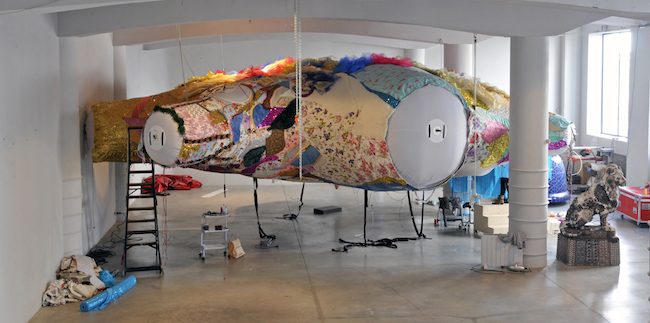
Photo: ©Unidade Infinita Projectos
In her book “Seven Days In the Art World”, Sarah Thornton visited three of Murakami’s workshops in Japan, places where artworks are being produced, for all practical purposes, like consumer products. The employees in the workshops revealed to Thornton that, often enough, the mood in the studio becomes quite trying – in Murakami’s workshops, every layer of paint must be documented so that a similar effect can be achieved in subsequent works. Even so, the employees are very grateful for having the opportunity to work with the artist, and they play according to his rules; interestingly enough, the works that the employees produce on their own time, outside of Kaikai Kiki, usually exhibit a completely different aesthetic and style than those of Murakami.
As we were viewing the Valkyrie work-in-progress taking place in the central workroom, Ms. Obst pointed out the traces of Eastern cultures visible in the piece: “Up to a certain point, that’s a contribution from the international team working here – influences from places such as India and Syria. In this sense, Joana is open.” When Sarah P. Hanson from Blouin Artinfo visited the studio in 2013, Vasconcelos commented on her piece “Contamination” so: “That’s what I mean with ‘contamination’: making your culture part of another, and leaving space for you to be contaminated by it in return.”
Vasconcelos dresses playful Bordalo Pinheiro ceramic animal figurines in filigree crochet. The lacework is made in various regions of Portugal, in techniques characteristic to each locale; at the atelier, the textiles are integrated into Vasconcelos’ compositions. Photo:
One of Vasconcelos’ innovations is the introduction of new colors in traditional lacework, as opposed to the usual white and cream. The same approach is applied to embroidery, in which the traditional approach is retained, but unusual colors and elements are adopted.
Interestingly enough, Vasconcelos was born in Paris – her parents having been Mozambique colonials – yet she selflessly works with the cultural heritage of Portugal. This can be especially seen in her support of regional lace-makers (some of whom have kept afloat only due to the orders coming in from the atelier), as well as with her extreme affinity for deconstructing the legacy of work left by the classic Portuguese artist Rafael Bordalo Pinheiro; in fact, playing with Pinheiro’s body of work has become a cornerstone of Vasconcelos’ artistic endeavors.
The faience factory founded by Bordalo Pinheiro in 1885, in the city of Caldas da Rainha, still operates today. Techniques that date back to more than a century are still kept alive, and copies of original Pinheiro pieces are still being manufactured. Thanks to its cooperation with the atelier, the factory has recently restored several 19th-century molds, and Pinheiro’s works are currently experiencing a new wave of popularity in Portugal.
Vasconcelos’ throne, or rather office, is found in the heart of the atelier. A Labrador retriever calmly ambles through the walk-through space. In the lounge area: a chair made from Disney-cartoon stuffed animals, by the eccentric Campana brothers (Fernando and Humberto Campana) from Brazil; Arne Jacobsen’s famous Egg Chair, as reinterpreted by Joana Vasconcelos. On the shelves: Bordalo Pinheiro faience originals. Photo:
Embroidery work for Vasconcelos’ “Shower” series of works is done in an ancient technique characteristic of Portugal’s northern regions. The embroidery is done on-site at the atelier, by a man – probably the only man under 60 years of age in Portugal who still has this skill. Photo:
In Vasconcelos’ case, there arises the question of whether cultural heritage can be saved from obscurity – and indeed, given a new life – through the acts of just one individual artist. Aren’t a stronger grasp and a larger scope necessary to pull this through? In principle, Vasconcelos’ atelier does not begin and end within the limits of its walls – it is actually a much larger organism, made up of a whole chain of larger and smaller institutions. Much as the tentacles of “Contamination”, themselves being sewn up from numerous scraps of cloth, the atelier spreads itself throughout all of Portugal’s regions, picking up bits of authentic culture and tradition wherever it lands.
It stands to mention that Vasconcelos makes use of not only tangible aspects of Portuguese culture. In her work “Red Independent Heart” (2008), a heart made from thousands of red plastic eating utensils spins to the melodic tones of the 20th-century legendary fado singer Amália Rodrigues.
Fado, the national music of Portugal, is still alive and kicking, and as the hour gets later, its sounds come to full-blooded pitch not far from the atelier – from the neighboring Bairro Alto and Alfama cafes. Fado has not become a wavering relic left to mold on dusty vinyl records – in Portugal, the people have a special ability to keep and maintain what is important; and Joana Vasconcelos has the special ability to bring this to the world. As she writes on her Instagram profile: “Artista plástica, from Lisboa to the world”.
The atelier is located in Lisbon’s harbor area, in the parish of Alcântara, on the banks of the Tejo river. From almost anywhere in the area there is a great view of the impressive 25th of April Bridge (Ponte 25 de Abril), which was named in honor of the 1974 Carnation Revolution. In the area around the atelier, one can also see one of Lisbon’s most memorable landmarks, the 16th-century Torre de Belém, or Tower of Belém, which played a prominent role in the age of Portugal’s great maritime discoveries. In 2008, Vasconcelos created a bauble of sorts for the Tower – the site-specific , a 12x13x13-meter installation made from buoys and ship towropes. As part of her national presentation at the Venice Biennale, Vasconcelos has also created a tile drawing – done in the azulejo style – featuring the Tower in its modern urban setting: . Photo:

.JPG)

